This requires more facilities in transmission and interconnection systems at optimum cost because transmission equipment is much costlier. So the choice between the AC and DC transmission is necessary in order to get the greater reliability. The best choice for the efficient and economical way of power transmission is the HVDC transmission. Let us discuss in brief about HVDC system.
What is HVDC?
The electric power is produced, transmitted and distributed as an AC power. From the generating stations, power is transmitted to the end user via transmission and distribution lines. Transmission lines are long and operates at high or extra high voltages. But, the amount of AC power transmission through the line is restricted by its inductance. To overcome this, a High Voltage DC (HVDC) transmission system is generally employed for high power transmission.
At the end of the DC power system, DC power is inverted to the AC power and synchronizes with succeeding AC network. So the entire HVDC consists of three sections, namely converter station, transmission portion and an inverter station. The sending end or converter station consists of 6, 12, or 24-pulse thyristor bridge rectifier while the receiving end or inverter station consists of a similarly configured thyristor bridge but which operates in inverter mode.
Advantages of HVDC over HVAC Transmission Systems
In DC transmission, only two conductors are needed for a single line. Only one conductor is enough using earth return and by using two conductors and earth return, the capacity of the line is doubled. But, in case of AC transmission, at least three conductors are needed and six conductors would be needed for double circuit line. It can transport power economically and efficiently over long distances with reduced transmission lines compared with losses in AC transmission. The DC link connected between two AC systems eliminates the need for maintaining the synchronization between them. The supply frequencies may or may not be equal on the two sides. HVDC systems always maintain the power flow as long as the voltage of the systems linked by HVDC is maintained at certain limits. But in case of HVAC system, synchronization of the supply frequency is must. The power flow in HVDC system can easily be controlled at high speed. The automatic controllers in the converter station determine the power flow through the link. No stability problems due to the transmission line length because no reactive power is needed to be transmitted. Fault isolation between the sending end and receiving end can be dynamically achieved due to fast efficient control of the HVDC link. In case of HVAC transmission for voltages greater than 400KV, it is necessary to limit the possible switching transients due to economic reasons. With the use of HVDC, such problems do not occur.
Components of an HVDC Transmission System
The essential components in a HVDC transmission system are 6/12/24 pulse converters, converter transformer with suitable ratio and tap changing, filters at both DC and AC side, smoothening reactor in DC side, shunt capacitors and DC transmission lines.
Converter Unit
HVDC transmission requires a converter at each end of the line. The sending end converter acts as a rectifier which converts AC power to DC power and the receiving end converter acts as an inverter which converts DC power to AC power. This unit usually consists of two three phase converter which are connected in series to form a 12 pulse converter. The converter consists of 12 thyristor valves and these valves can be packaged as single valve or double valve or quadrivalve arrangements. Due to the evaluation of power electronic devices, the thyristor valves have been replaced by high power handling devices such as gate turn-off thyristors (GTOs), IGBTs and light triggered thyristors. The valves are cooled by air, water or oil and these are designed based on modular concept where each module consists of a series connected thyristor levels. Firing signals for the valves are generated in the converter controller and are transmitted to each thyristor in the valve through a fiber optic light guide system. The light signals further converted into electrical signals using gate drive amplifiers with pulse transformers. The valves are protected using snubber circuits, gapless surge arrestors, and protective firing circuits.
Converter Transformers
The transformers used before the rectification of AC in HVDC system are called as converter transformers. The different configurations of the converter transformer include three phase- two winding, single phase- three winding and single phase- two winding transformers. The valve side windings of transformers are connected in star and delta with ungrounded neutral and the AC supply side windings are connected in parallel with grounded neutral. The design of the control transformer is somewhat different from the one used in AC systems . These are designed to withstand DC voltage stresses and increased eddy current losses due to harmonic currents. The content of harmonics in a converter transformer is much higher compared to conventional transformer which causes additional leakage flux and it results to the formation of local hotspots in windings. To avoid these hotspots, suitable magnetic shunts and effective cooling arrangements are required.
Filters
Due to the repetitive firing of thyristors, harmonics are generated in the HVDC system. These harmonics are transmitted to the AC network and led to the overheating of the equipment and also interference with the communication system. In order to reduce the harmonics, filters and filtering techniques are used. Types of filters include These are made with passive components and they provide low impedance and shunt paths for AC harmonic currents. Tuned as well as damped filter arrangements are generally used in HVDC system. Similar to AC filters, these are also used for filtering the harmonics. Filters used at DC end, usually smaller and less expensive than filters used in AC side. The modern DC filters are of active type in which passive part is reduced to a minimum. Specially designed DC filters are used in HVDC transmission lines in order to reduce the disturbances caused in telecommunication systems due to harmonics. These are provided to suppress the high frequency currents and are connected between converter transformer and the station AC bus. Sometimes these are connected between DC filter and DC line and also on the neutral side.
Shunt capacitors or Reactive Compensation
Due to the delay in the firing angle of the converter station, reactive volt-amperes are generated in the process of conversion. Since the DC system does not require or generate any reactive power, this must be suitably compensated by using shunt capacitors connecting at both ends of the system.
Smoothening reactor
It is a large series reactor, which is used on DC side to smooth the DC current as well as for protection purpose. It regulates the DC current to a fixed value by opposing sudden change of the input current from the converter. It can be connected on the line side, neutral side or at an intermediate location.
Transmission medium or lines or cables
Overhead lines act as a most frequent transmission medium for bulk power transmission over land. Two conductors with different polarity are used in HVDC systems to transfer the power from sending end to receiving end. The size of the conductors required in DC transmission is small for the same power handling capacity to that of AC transmission. Due to the absence of frequency, there is no skin effect in the conductors. High voltage DC cables are used in case of submarine transmission. Most of such cables are of an oil filled type. Its insulation consists of paper tapes impregnated with high viscosity oil.
DC and AC switchgear
The switchgear equipment provides the protection to the entire HVDC system from various electrical faults and also gives the metering indication. The switchgear equipments include isolator switches, lightening arrestors, DC breakers, AC breakers, etc.
Types of HVDC systems
There are mainly three types of HVDC links and are discussed below.
Monopolar Link
In this DC system, sending end and receiving end converters are connected by a single conductor (or line) with positive or negative polarity. Mostly negative polarity is preferred on overhead lines due to lesser radio interference. It uses ground or sea water as a return path. Sometimes a metallic return is also used. It is to be noted that earth offers less resistance to DC as compared with AC. The figure below shows a monoploar link.
Bipolar Link
This is the most commonly used configuration of HVDC system. It uses two conductors; one is a positive conductor or pole and the other negative conductor of the same magnitude (typically of ± 650V). Each terminal has two sets of converters of identical ratings connected in series on DC side. The neutral points (junction between the converters) are grounded at one or both ends and hence the poles operate independently. Normally, both poles are operated at same current and hence there is no ground current flowing under these conditions. In the event of a fault in one conductor, the other conductor with ground return can supply half the rated load and thus increase the reliability of the system. The bipolar link has two independent circuits and it can be operated as a monopolar link in an emergency situation.
Homopolar Link
This link has two or more conductors with the same polarity, usually of negative and they are operating with ground return. If fault takes place in one conductor, the converter equipment can be connected to healthy pole and it can supply more than 50% of the rated power by overloading at the expense of increased line loss. This is not possible in case of bipolar link where graded insulation is used for negative and positive poles. This system is preferred when continuous ground currents are inevitable. The advantage of the system is that less corona loss and radio interference due to the negative polarity on the lines. However the large earth return current is the major disadvantage.
Applications of HVDC Systems
Long distance bulk power transmission Bulk power transmission through underground or underwater cables Interconnection of individually controlled AC systems Stabilization of power flows in integrated power system AC and DC lines in parallel Frequency conversion DC transmission with AC distribution
Just a thing…. The sunset picture is from 3 AC lines… Not DC Comment * Name * Email * Website
Δ



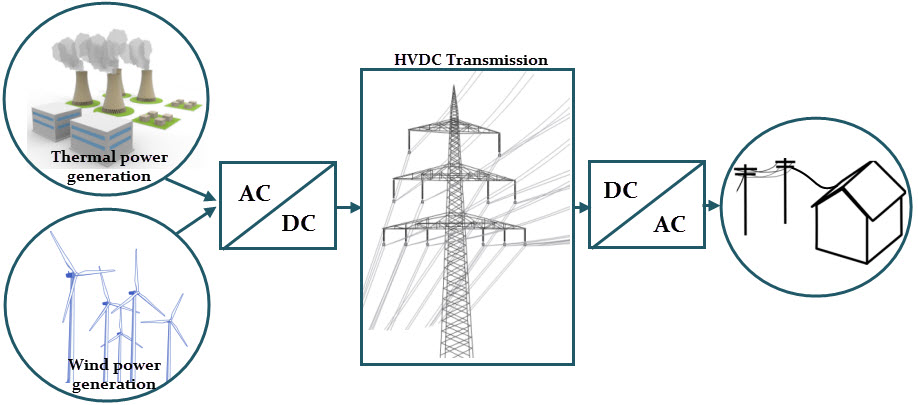
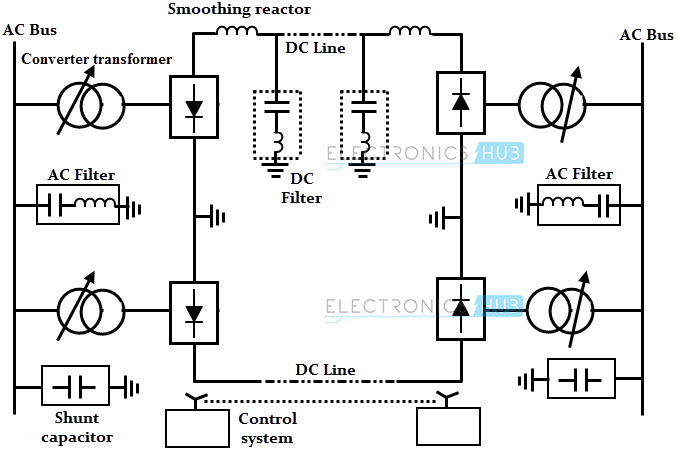
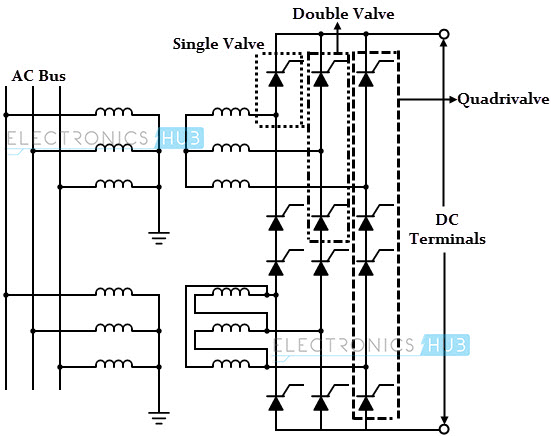
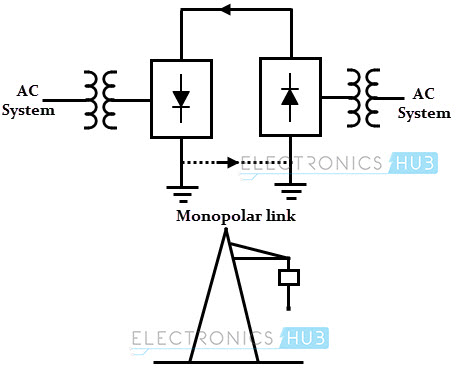
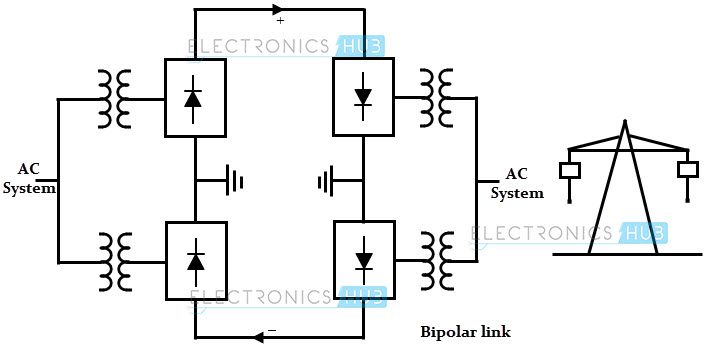
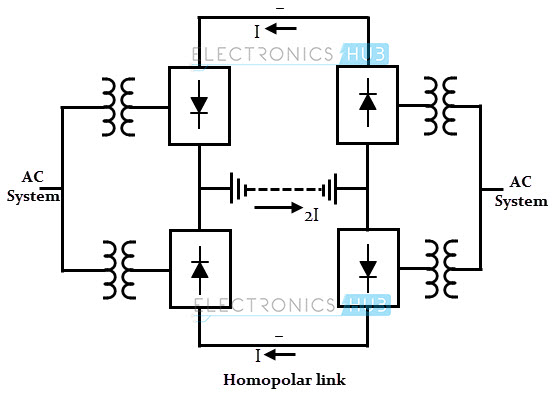


![]()